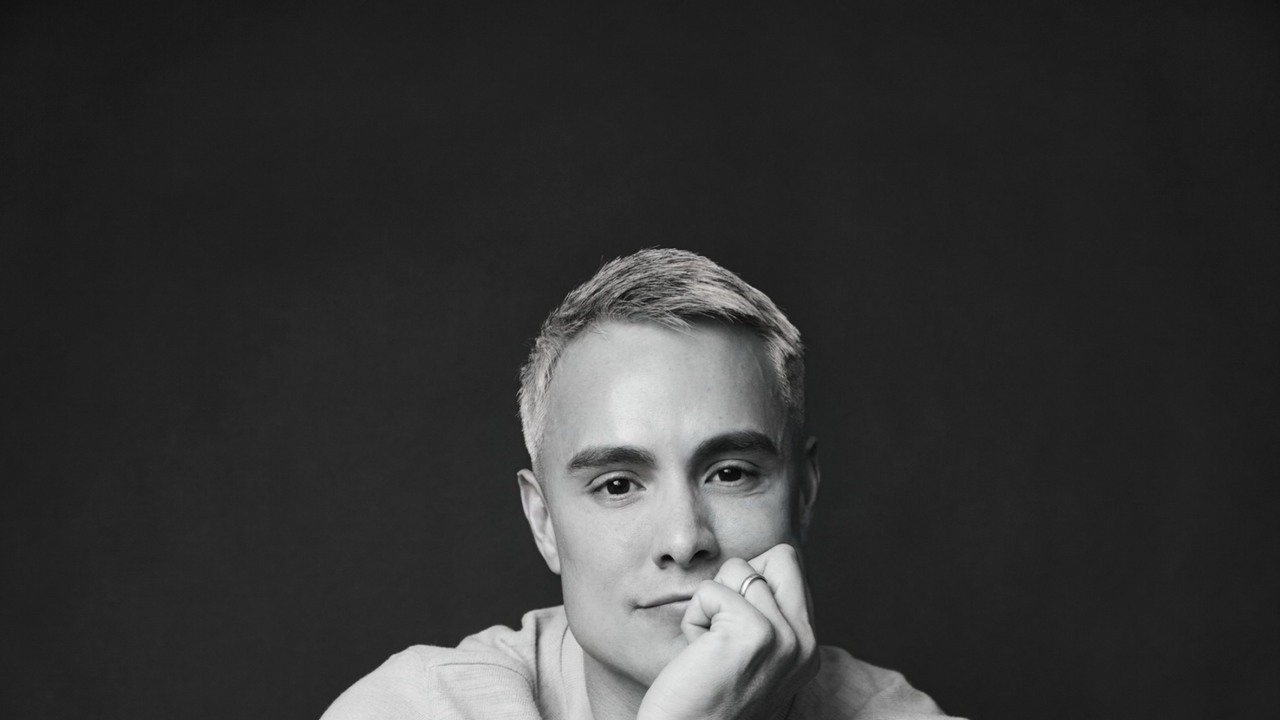Learn Ujjayi Pranayama (Ocean Breath): Steps, Benefits, and More
Ujjayi Pranayama, also known as Victorious Breath or Ocean Breath, is a traditional yogic breathing technique that involves gently constricting the throat to produce a soothing sound, similar to ocean waves. This steady “haaah” sound, felt at the back...
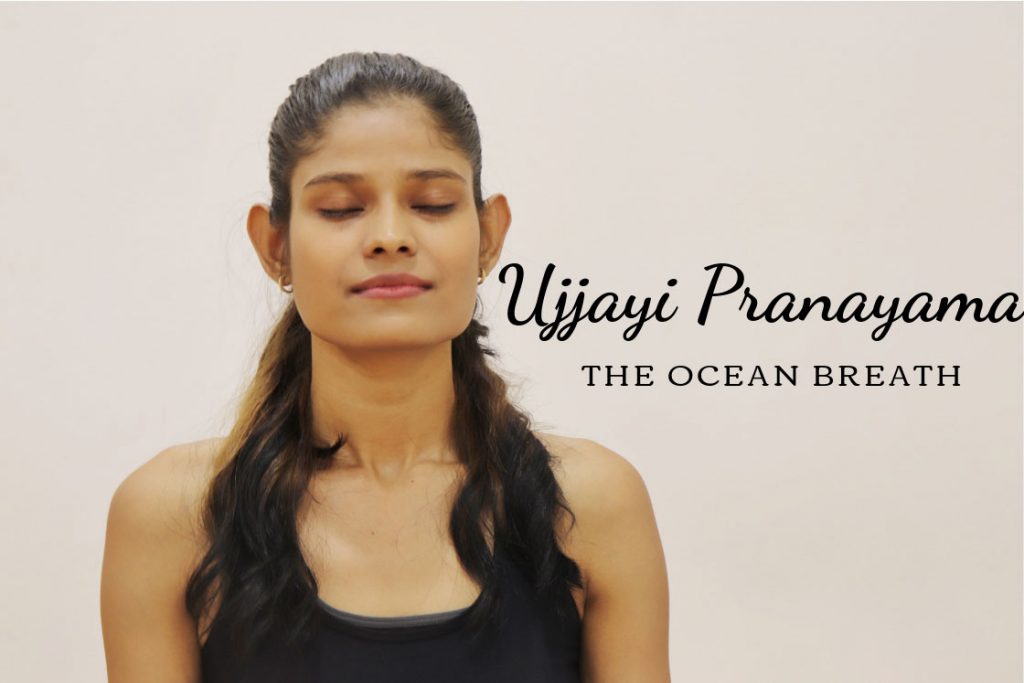
 Throat constriction in Ujjayi breathing. Image: Fitsri
Throat constriction in Ujjayi breathing. Image: FitsriUjjayi Pranayama, also known as Victorious Breath or Ocean Breath, is a traditional yogic breathing technique that involves gently constricting the throat to produce a soothing sound, similar to ocean waves. This steady “haaah” sound, felt at the back of the throat, helps slow down the breath and quiet the mind.
The purpose of Ujjayi breathing is to lengthen and deepen each breath cycle. For this reason, it is widely used in seated meditation as well as in dynamic practices like Vinyasa yoga. Names like Conqueror’s Breath, Psychic Breath, and Ocean Breath highlight its calming and energising effects on both the body and mind. To fully understand these names, it’s helpful to explore the meaning of the word Ujjayi
What does ujjayi mean?
Ujjayi (pronounced ooh-JAI-yee) is a Sanskrit word formed by combining the prefix “Ud” and the root “Ji”.
“Ud” implies rising or expansion, sometimes also interpreted as a sense of upward movement or liberation. “Ji” means to conquer or be victorious.Together, Ujjayi translates to “one who is victorious” or simply “victory.” This is why Ujjayi Pranayama is often referred to as Victorious Breath or Breath of Victory.
On a deeper level, “Ud” can also signify overcoming bondage, while “Ji” refers to the act of conquering. So, through the practice of Ujjayi, one experiences a feeling of inner victory as if breaking free from worldly distractions and mental restlessness. This gives rise to another name, Conqueror’s Breath.
Because of its calming effect on the nervous system and its ability to quiet the mind, Ujjayi is also known as the Psychic Breath.
Ujjayi is one of the eight classical pranayamas described in the ancient yogic text Hatha Yoga Pradipika.
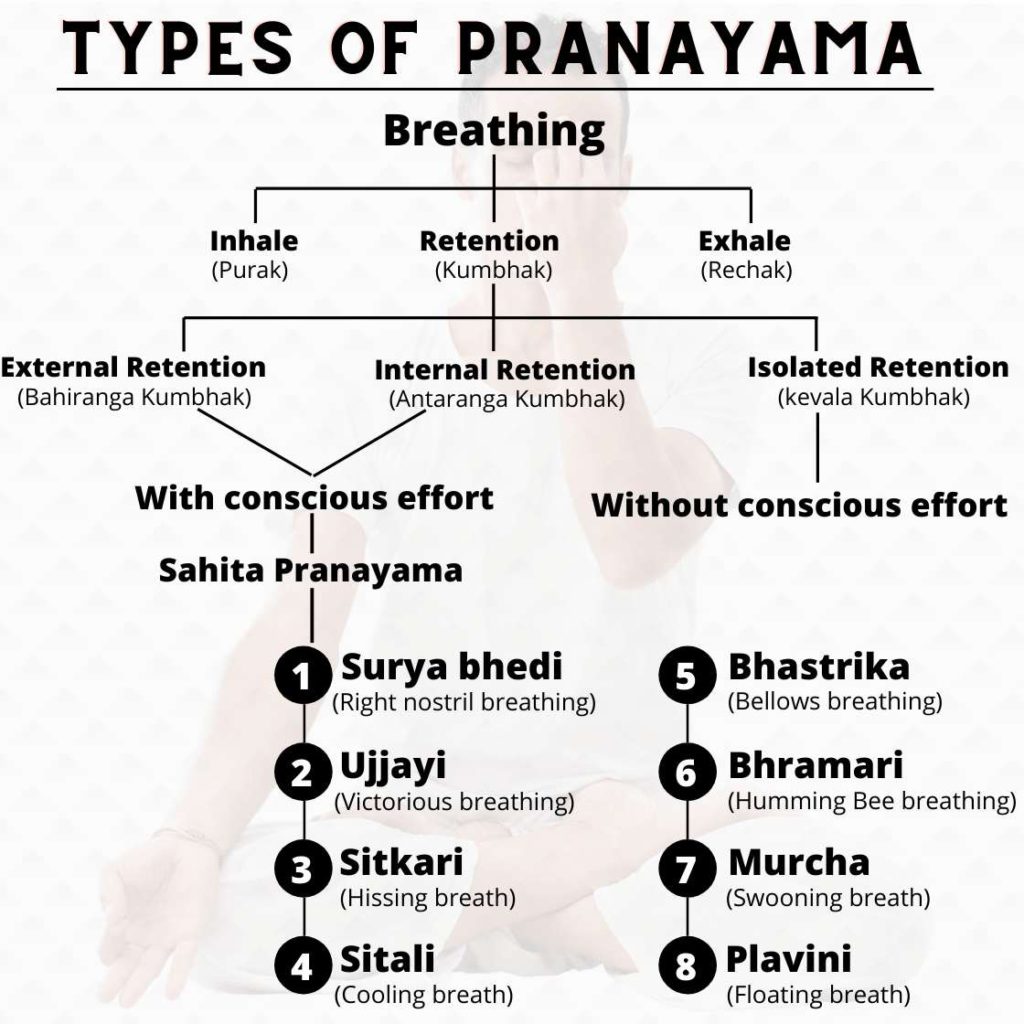 8 traditional types of pranayama. Image By: fitsri
8 traditional types of pranayama. Image By: fitsriIn this text, Ujjayi is said to give the practitioner immense power even the ability to resist decay and death symbolising mastery over life force through conscious breathing.
How ujjayi breathing works: role of the glottis & diaphragm
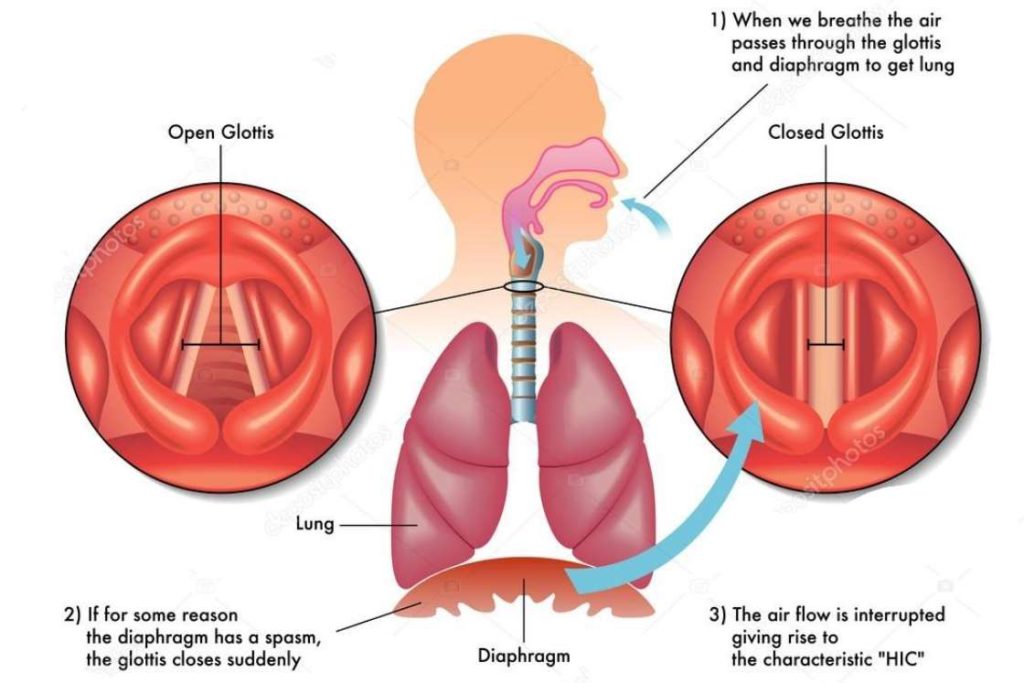 Glottis and diaphragm while breathing.
Glottis and diaphragm while breathing. The two main physical components involved in Ujjayi Pranayama are the glottis and the diaphragm.
The glottis is located in the middle of the larynx at the top of the throat, where the vocal cords sit. It works like a valve between the lungs and the mouth, just beneath the epiglottis. In Ujjayi breathing, gently narrowing the glottis helps slow the breath and produces the signature soft, wave-like sound.
Learning to control the glottis is key to mastering Ujjayi. This control creates resistance in the airway, which makes the breath more audible and intentional.
The second important part is the diaphragm the dome-shaped muscle located just below your lungs. It helps you draw air deep into your lungs. As the glottis shapes the breath’s path, the diaphragm controls the depth and length of each breath.
To practise Ujjayi effectively, you need to develop awareness and control of diaphragmatic breathing. The way your diaphragm moves determines how much air you inhale and how long you can sustain your breath.
How to create the ujjayi sound step by step
 Getting the sound produced in Ujjayi Pranayama. Image: Canva
Getting the sound produced in Ujjayi Pranayama. Image: CanvaBefore practising full Ujjayi Pranayama, it’s helpful to first get familiar with the sound it produces. This sound gives you a feel for the breath technique and helps you tune in to its calming rhythm.
Follow these simple steps to experience the Ujjayi sound:
Lift your hand in front of your face, palm facing your mouth. Breathe out naturally through your mouth and feel the air on your palm. Gently contract the back of your throat by slightly lowering your chin. With your mouth open, exhale slowly as if you’re trying to fog up a mirror. You’ll hear a soft “haaah” sound, like ocean waves rolling onto the shore. Now inhale in the same way, keeping the throat slightly constricted and the mouth open. The sound of inhaling will resemble the soft echo you hear when holding a seashell to your ear.Repeat this a few times until the sound feels natural.
Once you’re comfortable, try making the same sound with your mouth closed, breathing only through your nose. This is how Ujjayi Pranayama is traditionally practised steady nasal breathing with a gentle sound created at the back of the throat.
How to do ujjayi pranayama(step-by-step)

Step 1 – Sit comfortably
Sit in a stable, upright position. Sukhasana (Easy Pose) or Padmasana (Lotus Pose) are ideal. If these are uncomfortable, you can sit on a chair with your back straight and feet flat on the floor.
Keep your spine tall and shoulders relaxed. Place your hands on your knees. Gently close your lips to ensure you breathe only through your nose.Step 2 – Constrict the throat
Lightly press your tongue against the roof of your mouth. Bring your attention to the back of your throat, just below the epiglottis. Imagine narrowing this area slightly—like forming a small opening.
This gentle constriction of the throat muscles is what creates the signature Ujjayi sound. You won’t see it, but you can feel and imagine it as you breathe.
Step 3 – Engage the diaphragm and abdomen
Now focus on diaphragmatic breathing. As you inhale, allow your belly to expand outward, drawing breath deeply from the abdomen.
This should feel natural and effortless, like deep belly breathing. Let the diaphragm guide the breath while the glottis shapes the sound.Step 4 – Inhale through the nose with sound
Take a slow, deep breath in through your nose, directing the airflow through the narrowed throat. You should hear a soft, whispering sound — like ocean waves.
After inhaling, pause briefly for 2–3 seconds. Then slowly exhale through your nose, maintaining the same gentle throat constriction and sound.Although the breath moves through your nose, the sound and sensation should be felt at the back of your throat.
Step 5 – Repeat
One full cycle includes one inhale and one exhale. Start with 3 to 5 minutes of practice, gradually increasing duration as you get comfortable
Mechanism of ujjayi breathing
Ujjayi breath is a type of diaphragmatic breathing that involves the full range of internal organs from the lower belly to the throat.
Below mentioned steps shows how the movement of breath happens in the ujjayi pranayama.
The nose is the center for both inhalation and exhalation. Breath enters through the nose in Ujjayi. As we breathe in all air goes down into the lower belly through the constricted throat. Then from the lower abdomen, the breath moves upwards to the chest when inhalation converts to retention. After retaining breath at the chest for a while, exhalation begins. Here, Diaphragm controls the length and speed of the breath. In this stage, we constrict the vocal cords of the throat which restrict the passageway of air coming out of the throat. This constriction produces the sound of ‘Ocean Waves,’ which we called the Ujjayi sound.Advance practice of ujjayi pranayama
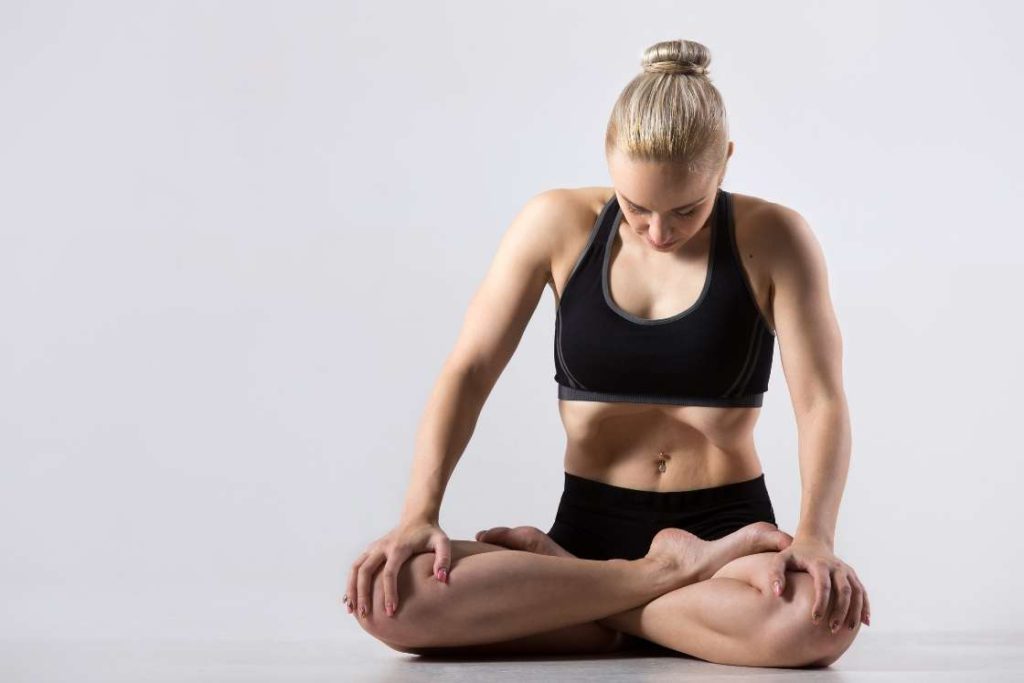 Ujjayi pranayama with Maha Bandha. Image: Canva
Ujjayi pranayama with Maha Bandha. Image: CanvaOnce you have developed a sufficient comfort level at practicing the previous steps you can look forward to adding a few more yoga elements to boost the benefits.
1. Ujjayi with Khechari Mudra
Practicing Ujjayi pranayama with Khechari Mudra is suggested especially when you want to increase the calmness and stress relief benefits. The khechari mudra is a very simple maneuver in your mouth, fold your tongue upward and backward so that the lower surface lies in contact with the upper palate. Extend backward with the tip of the tongue, without straining your mouth your tongue. Hold your tongue in this formation and continue with the previously mentioned instructions for Ujjayi Pranayama.
Performing Ujjayi in this way stimulates several pressure points located in the back of the mouth and the nasal cavity. They influence the body by stimulating the Prana and awakens kundalini shakti. It also affects the Vishuddhi chakra.
2. Ujjayi with Internal Retention
Ujjayi Breathing when performed with inner retention or Antar Kumbhaka, it generates additional heat and pulmonary benefits. Internal retention in the simplest term is holding your breath. Holding your breath develops strength in the chest wall muscles, increases lung capacity, and involvement rate of the alveolus to enhance respiration efficiency.
Follow steps 1, 2 & 3 of Ujjayi breathing. In step 4 instead of holding the breath for 2-3 seconds, hold it for a long but comfortable duration. Preferably for 10-15 seconds. As you exhale be gentle and slow. While holding in your breath ensure that your belly is tucked in, chest expanded on all sides, and shoulders not cringing but pressed down.
3. Ujjayi with Bandhas
After you master the Internal Retention, Bandhas can be incorporated with Ujjayi Breathing. The Bandhas incorporate body locks, that create concentrated pressure regions in your body, and accelerating very specific benefits. You can engage in either just the jalandhara bandha, or both jalandhara bandha and moola bandha. These bandhas will have a prominent effect on the flow and harnessing of energy in your body.
For the jalandhara Bandha at the very first step as you prepare your seating, you will tilt your head down and press your chin against the top of your breastbone and hold the lock. Continue with the rest of the Ujjayi breathing steps. This lock will help you cleanse your throat chakra and does ramp up the benefits to your throat muscles, vocal apparatuses, and thyroid and parathyroid glands.
Moola bandha cleanse your root chakra and biologically speaking it increases the flexibility, balance, and strength of the pelvic floor muscles. This body lock will also benefit your hormones, bladder functions, and bowel control. In a way, Moola bandha is a Kegel exercise. Once again as you prepare your seating for Ujjayi Pranayama, before starting the process of inhalation, you will need to contract your perineum muscles upward and hold them in a lock. Initially don’t hold this lock for very long, 5-10 seconds is fine. As a ground rule, relax your perineum muscles once they start to convulse from the lock. You can practice Moola Bandha and Jalandhara Bandha together as well.
When to practice ujjayi pranayama
Time and duration
Ujjayi Pranayama can be practised any time of day, but early morning or evening is considered most effective for calming the mind and balancing energy.
Avoid practising on a full stomach, as the abdominal engagement may interfere with digestion. Wait at least 2–3 hours after meals.
Start with 3 to 5 minutes, gradually increasing to 10–15 minutes daily as your comfort and breath control improve.
Ideal positions
You can practise Ujjayi in different postures depending on your needs:
On a yoga chair or in a comfortable seated pose In Vajrasana – helpful for managing back issues like spondylitis In Tadasana (Mountain Pose) – ideal for grounding and focus In Shavasana (Corpse Pose) – useful for easing sleep troublesWhen ujjayi Is most useful
As a preparation for meditation, to settle and focus the mind To calm the nerves during moments of anxiety, restlessness, or emotional stress Before Hatha Yoga practice, to build concentration and increase body awarenessUjjayi is a gentle yet powerful breathwork technique that supports mental clarity and physical relaxation in daily life.
Precautions and contraindications
While Ujjayi Pranayama appears gentle, it has a deep impact on the nervous, respiratory, and cardiovascular systems. To avoid negative effects, it’s important to practise with awareness and follow these safety guidelines:
Keep facial muscles relaxed while gently constricting the throat. Avoid over-tightening the throat. The constriction should be light and comfortable. Ensure the breath touches the throat. This helps create the soft Ujjayi sound. Maintain a balanced rhythm between inhalation and exhalation. Never force the breath or strain during practice.Health-related contraindications
Avoid Ujjayi if you have migraines, high blood pressure, or heart disease — unless supervised by an experienced yoga teacher or healthcare provider. Do not practise during pregnancy or after recent abdominal surgery, due to the abdominal involvement in diaphragmatic breathing. Limit practice to 5–7 minutes daily at the beginner level to prevent fatigue in the respiratory or cardiac system. Skip practice if you feel dizzy or constantly exhausted.Additional cautions with advanced variations:
While practising Khechari Mudra, avoid straining the tongue or facial muscles. During Jalandhara Bandha, do not overly tighten the neck or force the chin lock. For Moola Bandha, avoid holding the pelvic floor muscles too long—especially if you feel discomfort or muscle fatigue.If you are practising internal breath retention (Antar Kumbhaka), avoid it if you have chronic anxiety, lung conditions, or heart problems.
Lastly, avoid intense physical activity or demanding yoga postures immediately after Ujjayi Pranayama, as the body needs time to stabilise.
Benefits of ujjayi pranayama
Ujjayi Pranayama is a slow and steady yogic breath that creates a soft ocean-like sound, calming both the mind and body. This controlled breath technique supports mindfulness while activating key glands and improving respiratory, nervous, and cardiovascular health.
Regulates thyroid and parathyroid function: Ujjayi breath stimulates the throat area where the thyroid and parathyroid glands are located. This helps regulate hormones like T3, T4, parathyroid hormone, and calcitonin, which are responsible for metabolism, calcium balance, body temperature, and nervous system function. Supports heart health: By encouraging slow and steady breathing, Ujjayi reduces heart strain and promotes cardiovascular relaxation. A study from Ovidius University in Romania showed that 8 weeks of Ujjayi Pranayama significantly reduced resting heart rate and pulse rate, indicating better heart function. Naturally lowers blood pressure: Ujjayi breath improves circulation and relaxes the blood vessels by shifting the body into a parasympathetic (rest-and-digest) state. According to a study published in the National Journal of Physiology, Pharmacy and Pharmacology, Ujjayi breathing significantly lowers blood pressure and respiration rate by activating stretch receptors in the lungs. Improves lung capacity and breathing efficiency: The gentle resistance created by the throat constriction strengthens the diaphragm and increases oxygen intake. A study in the Journal of Sports reported that Ujjayi Pranayama increased vital lung capacity and breath-hold time, improving overall respiratory endurance. Enhances cognitive and motor functions: Ujjayi improves oxygen delivery to the brain, supporting better mental clarity, concentration, and motor coordination. Regular practice can help improve memory, reaction time, and focus especially during demanding tasks. Reduces stress and calms anxiety: The ocean-like sound and slow rhythm of Ujjayi help calm the nervous system and soothe mental agitation. This makes it effective for managing stress, anxiety, and emotional tension, even during high-pressure situations. Promotes deeper sleep and rest: When done before bedtime or in resting poses, Ujjayi activates the parasympathetic nervous system. This slows the breath and heart rate, making it easier to fall asleep and stay asleep longer. Strengthens vocal cords and improves voice control: As air moves through the narrowed throat passage, the vocal cords are gently toned. This strengthens the voice and improves breath control, which is especially helpful for public speakers, singers, and yoga instructors. Increases breath awareness: Ujjayi heightens your awareness of each breath by making it audible and controlled. This improves your ability to consciously regulate your breathing both on and off the mat. Boosts physical endurance: By increasing oxygen uptake and building lung strength, Ujjayi helps sustain energy levels during physical activity. Athletes and yoga practitioners often use it to maintain stamina and mental focus during long sessions.Conclusion
Ujjayi Pranayama, also known as psychic breath or victorious breath, is more than just a yogic breathing technique. It offers deep relaxation, mental clarity, and greater control over your energy. Regular practice enhances focus, patience, and emotional balance, making it a powerful tool for both beginners and advanced yoga practitioners.
Modern research supports what ancient yogis have known for centuries Ujjayi breathing helps manage stress, insomnia, anxiety, and even supports respiratory health. It balances the breath, increases oxygen intake, and builds internal warmth, preparing the body and mind for both meditation and physical yoga postures.
In today’s fast-paced world, Ujjayi Pranayama is a valuable form of daily self-care. With just a few minutes of mindful breathing each day, you can experience more calm, focus, and resilience in every area of your life.

 FrankLin
FrankLin 
































